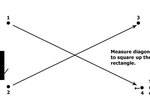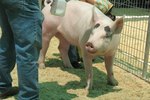
Pigs -- regardless of breed, size or level of domestication -- are notorious for rooting and digging. They subvert fences with apparent ease. Whether you want to keep your domestic pigs in or keep wild pigs out, you will need to reinforce your fence specifically for the purpose of keeping them from going underneath it.
Starting From Scratch
Pigs are strong, and they're surprisingly fast. Your best bet for discouraging pigs from going under, or through, you fencing is to build the sturdiest fence possible. If you're building a pen from scratch and your primary concern is pigs digging underneath the fence, then you want to choose a type of fencing that is difficult to penetrate. Wire fencing, including those made of hog wire, can be bent or torn by a determined pig. It is difficult to reinforce the bottom of a wire fence to be sure pigs can not dig under it, making hog wire a less-than-ideal choice if you want to prevent pigs from going underneath. The sturdiest fences are those made of concrete or solid wood. You can use electric fencing to contain hogs so long as your fence charger delivers a strong-enough shock that your pigs to respect it. If you are building a fence from scratch, you want the best-quality fence you are able to afford.
Preventing Ground-Level Escape
You can prevent pigs from going underneath your fence by creating a barrier that will physically stop them from going underneath. If you are in the initial stages of building your fence, you can make your fence very difficult to penetrate. Dig a trench directly underneath where you are planning to build your fence and bury a foot or two of fencing in the ground where your fence bottom is going to line up. If you have a pig who is very determined to dig under the fence, you may want to consider constructing a solid barrier such as one made of concrete underneath your fence line to prevent digging. You can do this by filling your trench with quick-drying concrete. If you already have your fence built, you need to incorporate your existing fence into your barrier. Dig your trench directly underneath your existing fence. Install a barrier in the trench and fasten it to the existing fence where the top of the underground barrier and the bottom of the fence come together. Woven wire fencing is a good choice for burying, as are concrete and pressure-treated wood.
Using Multiple Types of Fencing
It is common for pig owners to use multiple types of fencing together in efforts to keep pigs where they belong. A sturdy fence, such as one made of small-animal livestock panels or wood, is more secure when reinforced with several strands of electric fencing, for instance. An Auburn University web page recommends having hot electric wires located between 8 inches and 10 inches off the ground for pigs, with additional hot wires being placed at 16 to 18 inches and at 28 inches. If you are housing nursing pigs, you may want to lower the height of the bottom strand to 6 inches from the ground.
Providing for His Needs
Your pig may try to dig underneath your fence if his needs are not adequately met within his living enclosure. Make sure to provide your pig companionship, food and always clean water. He will also need an area of dirt where he can safely root in the ground without facing reprimand. A happy pig is less likely to try to escape than a pig who is hungry, thirsty or lonely. If you are keeping multiple pigs in a single enclosure, make sure all of them have their needs adequately met. Otherwise, escape attempts are more likely.
References
Photo Credits
-
Thomas Northcut/Digital Vision/Getty Images
Writer Bio
Jen Davis has been writing since 2004. She has served as a newspaper reporter and her freelance articles have appeared in magazines such as "Horses Incorporated," "The Paisley Pony" and "Alabama Living." Davis earned her Bachelor of Arts in communication with a concentration in journalism from Berry College in Rome, Ga.




